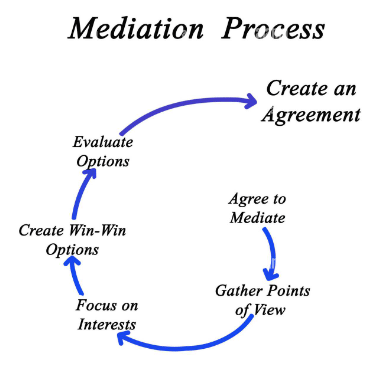 Although every conflict and every mediation process will be slightly different, there are a number of steps you need to consider and points to consider in each case.
Although every conflict and every mediation process will be slightly different, there are a number of steps you need to consider and points to consider in each case.
1. Preparation
You need to create ‘ground rules’ for the mediation process. Generally some basic rules of communication and confidentiality will be essential, but there may be others relevant to the situation. For example, you might want to set up that only one person speaks at a time, and that while someone is speaking, the others listen silently, that there will be no verbal abuse at any time, and that what happens is confidential unless both parties want to talk about it outside of mediation. agreed You may also wish to define the mediator’s role: to be neutral and help the parties reach their resolution, but to protect the parties from each other when necessary.
You should also consider whether you should hold separate meetings with each party to develop a better understanding of the issues before mediating a joint meeting.
2. Reconstructing and understanding conflict
Your job at this stage is to listen to the participants’ stories, either together or separately, and clarify what they want to achieve from the process.
If you meet both participants together, it is helpful if you can objectively summarize the main points of the dispute so that both can agree and propose an agenda for discussion: an order in which the issues should be discussed. Naming the emotions that participants are experiencing can also be helpful at this stage, to show that they are recognized and understood.
3. Determining points of agreement and dispute
At this stage, your role is to help participants move to a position where they begin to understand each other’s perspectives and can then begin to solve a shared problem.
One way to do this is to think of it as moving from a focus on the past to the future. Paraphrasing and summarizing in neutral language can also be helpful to help participants identify areas of agreement and check understanding. Reflecting feelings back to participants is powerful, as it shows both that they have been heard.
If you feel things are getting a little heated, don’t be afraid to suggest a coffee break or a walk outside, or even adjournment for another day. ‘Time out’ is a valuable reflection opportunity for everyone.
4. Making options for contracts
A useful starting point for this stage is to identify the easiest area, or the one on which there is the most agreement, and suggest addressing it first to provide a ‘quick win’.
Useful techniques for developing alternatives include brainstorming. At this stage, ‘anything goes’! You then need to help participants develop evaluation criteria, which should ideally be objective and in order of importance.
Your role here is mainly to ensure that all participants are equally involved in developing options and evaluation criteria and that they cover all parts of the problem. Make sure you reflect their opinion and not your own, but you can point out connections between options and/or problems.
Once the options have been evaluated, you need to guide them to a single solution that suits all parties, and help them fine-tune it if necessary.
5. Development of a contract
Like objectives, a contract should be smart, specific, measurable, achievable, realistic and time-bound. You can help participants achieve this by:
=>> Write the proposal in neutral language, and read it to them.
=>> Write individual points so that they are clear and understandable.
=>> Clarifying any general or ambiguous issues, for example, by asking participants to agree to concrete behavioral changes with achievement deadlines.
=>> Avoid legalese and keep things simple.
=>> Summarize progress and next steps, including setting a deadline for any future meetings and identifying remaining areas of difficulty and options for addressing them.
=>> Being positive about progress and everyone is engaged.
=>> Providing your continued support as an intermediary when needed.
=>> Making sure both parties sign the agreement then and there and closing the meeting once the agreement is reached.

 Follow
Follow